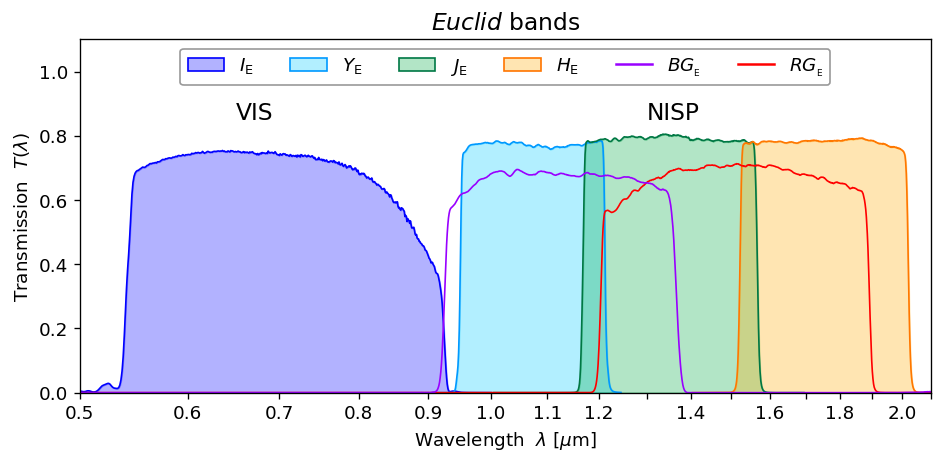Euclid for Scientists: overview
Euclid is a science mission. The For Scientists menu contains more specialised info aimed at scientists wanting to work with Euclid data and stay up to date with developments in the EC and the Euclid mission. This summary below is meant as a quick reference for key facts and numbers, as well as the papers from which these are taken, which contain deeper background information. The current central Euclid reference paper (replacing the Euclid Red Book) is EC: Mellier et al. 2024.
Basic mission data
Satellite
Launcher: SpaceX Falcon 9 from Cape Canaveral
Orbit: Sun-Earth Lagrange point 2 (L2)
Telescope
Type: Korsch off-axis three mirror anastigmat; Silicon Carbide telescope
Aperture: 1.20m diameter primary mirror, 9926cm² effective collection area
Focus: 24.5m focal length; paraxial F-number F/20.42
Dichroic element: reflected beam to VIS, transmitted beam to NISP instrument
Prime reference for mission design parameters (will be updated for/after launch): Racca+ 2016
Visible instrument, VIS
- detector array: 36 4x4k pixel CCD273-84, produced by Teledyne E2V; detectors read from each corner, 144 read channels
- 16-bit digitisation, 3.4 e-/ADU; <4.4 electrons internal noise in VIS detection chain
- pixel scale: 0.1 arcsec (slightly undersampling diffraction limit)
- effective angular resolution: 0.18 arcsec (through multiple exposures)
- field of view: 0.57 deg2
- single passband: IE=530-920nm, defined by dichroic reflection and combined effect of mirror coatings
- shutter unit
- calibration source (VIS-CU), for flat-fields and other calibration purposes: using LEDs at 6 wavelenghts

Near Infrared Spectrometer and Photometer, NISP
- detector array: 16 2x2k H2RG detectors, produced by Teledyne
- pixel scale: 0.3 arcsec (undersampling the PSF)
- radius of 50%/80% encircled energy (note: these are requirements; actual value will differ and be known only after launch):
- rEE50: <0.4 arcsec
- rEE80: <0.7 arcsec
- spectral elements: in filter wheel (FWA) and grism wheel (GWA)
- photometry passbands (50% cut-on to 50% cut-off, from Euclid Consortium: Schirmer+ 2022, Tab. 3):
- YE: 949.6nm-1212.3nm
- JE: 1167.6nm-1567.0nm
- HE: 1521.5nm-2021.4nm
- grism passbands (50% cut-on to 50% cut-off):
- BGE (from grism BGS000, orientation 0°): 926nm-1366nm, R~400
- RGE (from grisms RGS000/RGS180, orientations 0°, 180° [RGS270 is unused]): 1206nm-1892nm, R~480
- calibration unit (NI-CU), for flat-fields and other calibration purposes:
- 5 LEDs from ~920 to ~2000 nm
Surveys
Euclid will conduct two major surveys, the Euclid Wide Survey (EWS) and the Euclid Deep Survey (EDS), as well as repeatedly cover two fields to increase spectroscopic completeness and decrease confusion (CPC fields), and a number of legacy fields, the Euclid Auxilliary Fields (EAFs).
Prime reference for the EWS but also giving initial info on EDS, CPC, and EAFs: Euclid Consortium: Scaramella+ 2022.
Euclid Wide Survey
The EWS will cover up to 14,500 deg2 over a background- and contaminant-optimised extra-galactic and extra-ecliptic part of the sky.
Each field will receive one Euclid visit, each visit with:
- four VIS IE exposures (each 560.52s shutter fully open),
- one short VIS IE exposure (89.52s),
- four NISP red grism exposures at different grism orientations (each 549.6s),
- four NISP YE, JE, HE exposures (each 87.2s).
Median limiting sensitivities, AB zeropoint, for 5σ point-like source, over the EWS reference survey footprint (EC: Scaramella+ 2022, Tab. 7 and Figs. 19+21):
- VIS visible band: IE=26.2
- NISP near infrared bands:
- YE=24.3
- JE=24.5
- HE=24.4
- NISP slitless spectroscopy, Hα line flux limit: 2 × 10−16 erg cm−2 s−1 at 1600 nm
- Diffuse emission, surface brightness limits (1sigma over a 10×10 arcsec area):
- IE=29.8 mag arcsec−2
- YE=28.2 mag arcsec−2
- JE=28.4 mag arcsec−2
- HE=28.4 mag arcsec−2
Euclid Deep Survey
The EDS will cover ~53 deg2 split over three fields, with field-centers in Equatorial (celestial) coordinates (RA/Dec.):
- EDF-North (EDFN, 20 deg2 x 40 visits): 17:58:55.9 +66:01:03.7
- EDF-South (EDFS, 23 deg2 x 45 visits): 04:04:57.84 -48:25:22.8
- EDF-Fornax (EDFF, 10 deg2 x 53+ visits): 03:31:43.6 -28:05:18.6
The reference for EDF locations, shapes, and details is the ESA Euclid Deep Field page.
Euclid CPC fields
The Euclid CPC fields will each subtend 20 deg2 and will be repeatedly observed at different times to obtain grism spectroscopy at different orientation angles on the sky. Their field centers have been chosen to coincide with the EDF-North and EDF-South, so the CPC fields are not separate fields from the EDS fields.
Euclid Auxiliary Fields
The EAFs will be used to calibrate photometric redshifts and colour-gradients (EC: Scaramella+ 2022, Sec. 6.2). They are these six well-known fields, plus an extra field for photometric self-calibration of the survey. Depth refers to increase in SNR compared to the Wide Survey:
| Field Name | RA | Dec | Area [deg²] | Depth |
|---|---|---|---|---|
| Self-calibration (inside EDFN) | 268.813 | +65.29 | 2.5 | 8× |
| CANDELS/AEGIS | 214.827 | +52.82 | 1.0 | 4× |
| GOODS-NORTH | 189.250 | +62.25 | 0.5 | 4× |
| COSMOS-Wide | 150.119 | +02.21 | 2.0 | 5× |
| VVDS-Deep | 36.500 | −04.50 | 0.5 | 5× |
| CDFS (inside EDFF) | 53.117 | −27.81 | 0.5 | 5× |
| SXDS | 34.500 | −05.00 | 2.0 | 5× |
Updated: 2024-06-21, KJ
